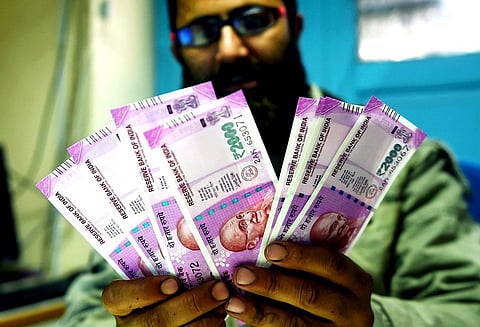

Fitch Ratings on Thursday lowered India's outlook to negative from stable for the first time in eight years saying the coronavirus pandemic had significantly weakened the country's growth outlook for the year and exposed the challenges associated with a high public-debt burden.
The international rating agency, however, retained India's rating at 'BBB-', which is the lowest investment grade and a notch above junk, and said that there are considerable risks to growth.
Fitch expects economic activity to contract by 5% in the fiscal year ending March 2021 (FY21) from the strict lockdown measures imposed since March 25, before rebounding by 9.5% in 2021-22.
"The coronavirus pandemic has significantly weakened India's growth outlook for this year and exposed the challenges associated with a high public-debt burden. The rebound will mainly be driven by a low-base effect," it said, while revising the outlook on India's long-term foreign-currency issuer default rating (IDR) to negative from stable.
Fitch had last in 2012 cut India's outlook to negative, from stable. In 2013, the agency had again upped the outlook to stable.
It projected general government debt to jump to 84.5% of the gross domestic product (GDP) in FY21 from an estimated 71% of GDP in FY20.
Fitch said the geopolitical risk related to longstanding border issues with India's neighbours was highlighted again by recently intensified tensions with China.
Relations with Pakistan are, moreover, negatively affected by the repeal of the special status for Kashmir and recent changes to the status of illegal immigrants based on their religion.
"A stronger focus by the ruling Bharatiya Janata Party on its Hindu-nationalist agenda since the government's re-election in May 2019 risks becoming a distraction for economic reform implementation and could further raise social tensions," Fitch added.
The rating agency said the government has announced structural reforms as part of its response to the pandemic to strengthen GDP growth over the medium term, which, if successful, could improve India's fiscal position.
The reforms to improve the efficiency of agricultural supply chains could help reduce food prices and swings in inflation, while intention to privatise state-owned enterprises (SOE) could prove to be transformative, it added.
Fitch, however, said its growth forecasts are subject to considerable risks due to the continued acceleration in the number of new COVID-19 cases as the lockdown is eased gradually.
"It remains to be seen whether India can return to sustained growth rates of 6 to 7% as we previously estimated, depending on the lasting impact of the pandemic, particularly in the financial sector," Fitch said.
Fitch's rating action comes after another rating agency Moody's earlier this month downgraded India's sovereign rating by a notch to lowest investment grade of 'Baa2' for the first time in 22 years.
US-based S&P, however, retained India's rating at 'BBB-', with a stable outlook saying that even though risks to growth are rising, the economy and fiscal position will stabilise and begin to recover from 2021 onwards.
While Moody's has projected GDP growth to shrink by 4% S&P pegged contraction at 5% in current fiscal.
Fitch said the humanitarian and health needs have been pressing, but the government has shown expenditure restraint so far due to the already high public-debt burden going into the crisis with additional relief spending representing only about 1% of GDP.
"Most elements of an announced package totalling 10%of GDP are non-fiscal in nature," it said.
Some further fiscal spending of up to 1 percentage point of GDP may still be announced in the next few months, which was indicated by a recent announcement of additional borrowing for FY21 of 2% of GDP, although we do not expect a steep rise in spending, it added.
India's fiscal metrics, it said, has deteriorated significantly, notwithstanding the government's expenditure restraint, due to the impact of the severe growth slowdown on revenue, the fiscal deficit and public-sector debt ratios.
"India's medium-term GDP growth outlook may be negatively affected by renewed asset-quality challenges in banks and liquidity issues in non-banking financial companies. The financial sector was already facing weak business and consumer confidence before the crisis and authorities had to deal with some high-profile cases over lapses in governance," it said.
A renewed rise in non-performing loans and the need for further financial government support now seem inevitable despite regulatory measures announced by the Reserve Bank of India.
These measures include an extension of the 90-day moratorium on recognition of impaired loans to 180 days and several relaxations in bank lending limits such as allowing banks to fund interest on working-capital loans.
"These moves will put a heavy onus particularly on public-sector banks to bail out the affected sectors and extend impaired-loan recognition, heightening solvency risks if not met by adequate and timely capital support," it said.